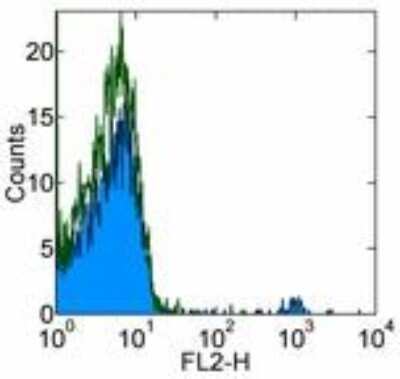TCR gamma/delta Antibody (B1.1) - BSA Free, Novus Biologicals
Bio-Techne includes Novus Biologicals | Catalog # NBP1-43121

Conjugate
Catalog #
Key Product Details
Species Reactivity
Validated:
Human
Applications
Flow Cytometry, Immunoprecipitation
Label
Unconjugated
Antibody Source
Monoclonal Mouse IgG1 kappa Clone # B1.1
Format
BSA Free
Concentration
0.5 mg/ml
Product Summary for TCR gamma/delta Antibody (B1.1) - BSA Free
Immunogen
The immunogen for this antibody was gamma delta TCR.
Clonality
Monoclonal
Host
Mouse
Isotype
IgG1 kappa
Scientific Data Images for TCR gamma/delta Antibody (B1.1) - BSA Free
Flow Cytometry: TCR gamma/delta Antibody (B1.1) [NBP1-43121] - Analysis using the Biotin conjugate of NBP1-43121. Staining of normal human peripheral blood cells with 2 ug of Mouse IgG1 K Isotype Control Biotin (open histogram) or 2 ug of Anti-Human gamma delta TCR Biotin (filled histogram) followed by Streptavidin PE. Cells in the lymphocyte gate were used for analysis.
Flow Cytometry: TCR gamma/delta Antibody (B1.1) [NBP1-43121] - Surface staining of normal human peripheral blood cells with AntiHuman gamma delta TCR FITC (left) or PE (right). Appropriate isotype controls were used (open histogram). Cells in the lymphocyte gate were used for analysis.
Applications for TCR gamma/delta Antibody (B1.1) - BSA Free
Application
Recommended Usage
Flow Cytometry
1:10-1:1000
Immunoprecipitation
1:10-1:500
Application Notes
The B1.1 antibody has been tested by flow cytometric analysis of human peripheral blood leukocytes. This can be used at less than or equal to 1 ug per test.
Please Note: Optimal dilutions of this antibody should be experimentally determined.
Formulation, Preparation, and Storage
Purification
Protein A or G purified
Formulation
PBS (pH 7.2)
Format
BSA Free
Preservative
0.09% Sodium Azide
Concentration
0.5 mg/ml
Shipping
The product is shipped with polar packs. Upon receipt, store it immediately at the temperature recommended below.
Stability & Storage
Store at 4C. Do not freeze.
Background: TCR gamma/delta
In humans, T cells expressing TCR gamma delta represents ~1-5% of total T cells in the peripheral blood but can comprise up to 50% of lymphoid cells in peripheral tissues like the intestines or dermis (3). The TCR gamma delta lineage arises from the double negative 3 (DN3) (CD44-,CD25-) stage of development where the cells receive strong TCR signals for gamma/delta selection (2). In contrast to alpha/beta T cells which are CD4+/CD8+, most gamma delta T cells are CD4-/CD8- (2). Gamma delta T cells produce different cytokines in response to varying degrees of signal received through the gamma delta TCR: a weaker signal induces interleukin (IL)-17, a moderate signal induces interferon (IFN)-gamma, and a strong signal stimulates IL-4 production (2,4). There are multiple gamma delta T cell subsets which are defined by the variable segments of the gamma and delta chain present after gene rearrangement (1,3,5). For example, Vgamma9Vdelta2 (Vgamma9Vdelta2) TCRs are expressed on the main subset of gamma delta T cells in human blood (1,3,5). Human gamma delta T cells expressing Vgamma9Vdelta2 TCR recognizes phosphoantigens that are released by tumor cells (3). The phosphoantigens bind butyrophilin (BTN) family members, such as BTN3A1/CD277, that are expressed on tumor cells and this interaction helps stimulate gamma delta T cell activation and tumor recognition (3). Considering their role in tumor recognition and killing, gamma delta T cells and the TCRs may be leveraged for cancer immunotherapies (3,4,6). Strategies for utilizing gamma delta T cells in immunotherapy include chimeric antigen receptor (CAR) transduction in gamma delta T cells, in vivo activation of gamma delta cells with anti-BTN3A1 monoclonal antibodies, or bispecific gamma delta T cell engagers (6).
References
1. Morath, A., & Schamel, W. W. (2020). AB and GD T cell receptors: similar but different. Journal of Leukocyte Biology, 107(6), 1045-1055. https://doi.org/10.1002/JLB.2MR1219-233R
2. Zarin, P., Chen, E. L., In, T. S., Anderson, M. K., & Zuniga-Pflucker, J. C. (2015). Gamma delta T-cell differentiation and effector function programming, TCR signal strength, when and how much?. Cellular Immunology, 296(1), 70-75. https://doi.org/10.1016/j.cellimm.2015.03.007
3. Silva-Santos, B., Serre, K., & Norell, H. (2015). GD T cells in cancer. Nature Reviews. Immunology, 15(11), 683-691. https://doi.org/10.1038/nri3904
4. Hahn, A. M., & Winkler, T. H. (2020). Resolving the mystery-How TCR transgenic mouse models shed light on the elusive case of gamma delta T cells. Journal of Leukocyte Biology, 107(6), 993-1007. https://doi.org/10.1002/JLB.1MR0120-237R
5. Fichtner, A. S., Ravens, S., & Prinz, I. (2020). Human GD TCR repertoires in health and disease. Cells, 9(4), 800. https://doi.org/10.3390/cells9040800
6. Kabelitz, D., Serrano, R., Kouakanou, L., Peters, C., & Kalyan, S. (2020). Cancer immunotherapy with gammadelta T cells: many paths ahead of us. Cellular & Molecular Immunology, 17(9), 925-939. https://doi.org/10.1038/s41423-020-0504-x
Alternate Names
delta polypeptide, T3D, TiT3
Gene Symbol
TRG
Additional TCR gamma/delta Products
Product Documents for TCR gamma/delta Antibody (B1.1) - BSA Free
Product Specific Notices for TCR gamma/delta Antibody (B1.1) - BSA Free
This product is for research use only and is not approved for use in humans or in clinical diagnosis. Primary Antibodies are guaranteed for 1 year from date of receipt.
